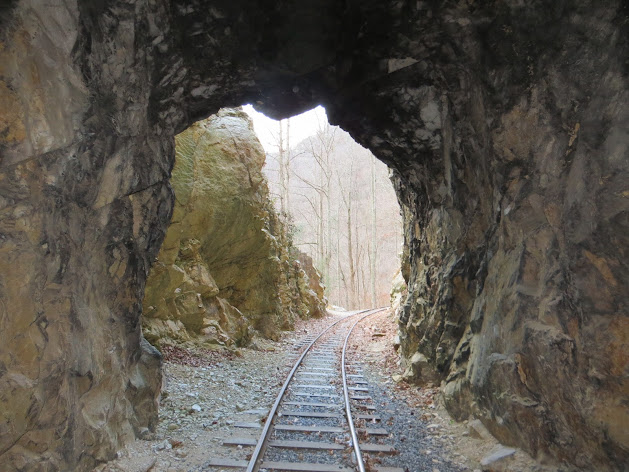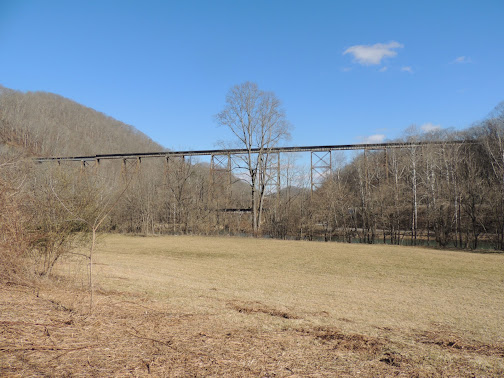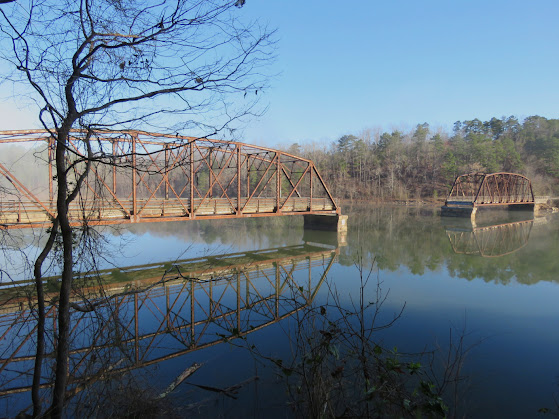Blevins Bridge, Roan Mountain, TN
Given the mountainous route, the busiest engine on the legendary Tweetsie Railroad was always called "the little engine that could." Turns out, at least one of the bridges that ferried that engine and its cargo over the Doe River should have been called "the little bridge that could... have ties to a major steel icon and a worldwide business conglomerate."
Industrialist Andrew Carnegie was renowned in the iron and steel manufacturing world in the late 19th century. As steel mills were expanding from northern cities and establishing factories in the South, Carnegie founded the Keystone Bridge Company in 1865 under his company, the Carnegie Steel Company of Pittsburgh, PA (the Keystone Bridge Company was later absorbed into the American Bridge Company in 1900, still active today as a subsidiary of U.S. Steel).
Back in its bridge building heyday, one of Keystone's most notable bridges was the Eads Bridge built in 1874 at St. Louis, Missouri, the oldest bridge still standing across the Mississippi River and profiled in this column previously. It's amazing that a company as far-reaching as Keystone, could ever be involved with a small steel truss bridge in East Tennessee!

But it was. Rich iron ore deposits in the North Carolina high country eventually attracted Andrew Carnegie to Johnson City, Tennessee (which is quite a story within itself---the name of Johnson City was almost changed to Carnegie, Tennessee!).
Enter the narrow-gauge East Tennessee and Western North Carolina Railroad in 1881-1882, extended through the narrow Doe River Gorge to become the conveyor of the mined iron ore from the Cranberry Iron Works in eastern Avery County, NC to Tennessee. The ET & WNC ferried the cargo from Cranberry (and later Boone, NC) westward through the gorge east of Hampton and then to Elizabethton to downtown Johnson City and its connection with the East Tennessee, Virginia and Georgia Railroad (now the Norfolk-Southern). Five wooden Howe covered truss bridges with three of them within the gorge itself were built on the narrow gauge across the Doe River at that time but flooding heavily damaged them around 1900.
All of the bridges were replaced with relocated steel truss bridges. Those three steel truss bridges survive today, with one of them being the Blevins Bridge, originally built by Carnegie's Keystone Bridge Company, relocated and reassembled in 1909 from another crossing.
Its nameplate retains the original assembly year, but its previous location before the Blevins community is not known.
The Blevins Bridge is a single span, one lane pin-connected Pratt truss, 110 feet long and about 25 feet tall. Its top chords and laced end posts are with ornamental portal bracing at the tops and bottoms, making it quite the picturesque bridge. The bottom chords that parallel the deck are paired rectilinear eye bars through which the pins connect to, almost like threading giant heavy steel sewing needles. The bridge rests on masonry abutments common to late 19th century bridge construction.
According to historic records at the Tennessee Department of Transportation, the Blevins Bridge was the only bridge constructed by the Keystone Bridge Company in the state. A bridge built by the company began by Andrew Carnegie.
When the narrow gauge portion of the ET & WNC (later nicknamed the "Tweetsie") Railroad shut down between Elizabethton and Cranberry in 1950, the railroad bed eventually became a Carter County road (Old Railroad Grade Road) in 1967 and the Blevins Bridge was converted at that time to one-lane vehicular traffic.
Because of its historic ties through the Keystone Bridge Company, Andrew Carnegie, and the East Tennessee and Western North Carolina narrow gauge railroad (Tweetsie), not to mention its connection to what was once thought to be one of the largest iron ore deposits in the country and other notables, the Blevins Bridge is eligible for the National Register of Historic Places.










